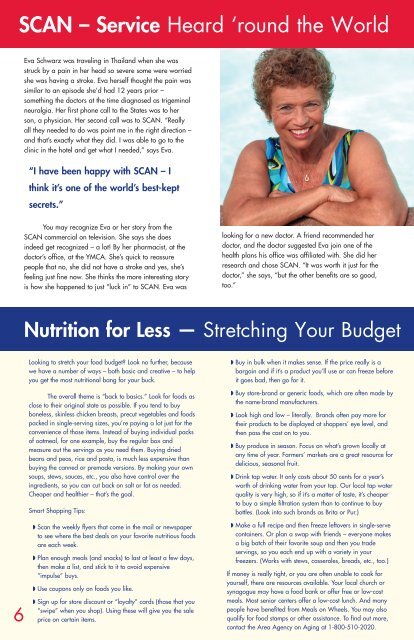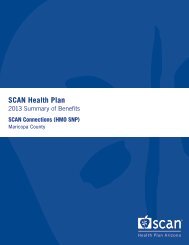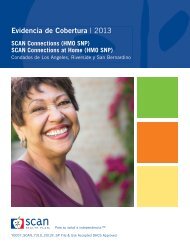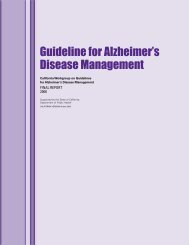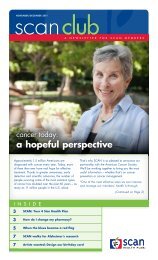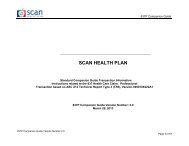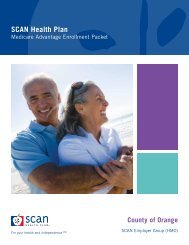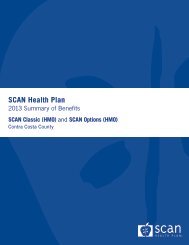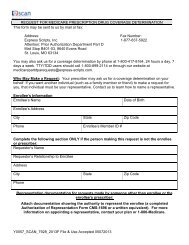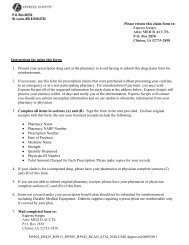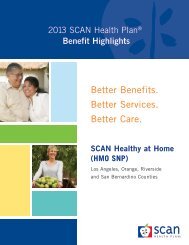INSIDE - SCAN Health Plan
INSIDE - SCAN Health Plan
INSIDE - SCAN Health Plan
Create successful ePaper yourself
Turn your PDF publications into a flip-book with our unique Google optimized e-Paper software.
<strong>SCAN</strong> – Service Heard ‘round the World<br />
Eva Schwarz was traveling in Thailand when she was<br />
struck by a pain in her head so severe some were worried<br />
she was having a stroke. Eva herself thought the pain was<br />
similar to an episode she’d had 12 years prior –<br />
something the doctors at the time diagnosed as trigeminal<br />
neuralgia. Her first phone call to the States was to her<br />
son, a physician. Her second call was to <strong>SCAN</strong>. “Really<br />
all they needed to do was point me in the right direction –<br />
and that’s exactly what they did. I was able to go to the<br />
clinic in the hotel and get what I needed,” says Eva.<br />
“I have been happy with <strong>SCAN</strong> – I<br />
think it’s one of the world’s best-kept<br />
secrets.”<br />
You may recognize Eva or her story from the<br />
<strong>SCAN</strong> commercial on television. She says she does<br />
indeed get recognized – a lot! By her pharmacist, at the<br />
doctor’s office, at the YMCA. She’s quick to reassure<br />
people that no, she did not have a stroke and yes, she’s<br />
feeling just fine now. She thinks the more interesting story<br />
is how she happened to just “luck in” to <strong>SCAN</strong>. Eva was<br />
looking for a new doctor. A friend recommended her<br />
doctor, and the doctor suggested Eva join one of the<br />
health plans his office was affiliated with. She did her<br />
research and chose <strong>SCAN</strong>. “It was worth it just for the<br />
doctor,” she says, “but the other benefits are so good,<br />
too.”<br />
Nutrition for Less — Stretching Your Budget<br />
6<br />
Looking to stretch your food budget? Look no further, because<br />
we have a number of ways – both basic and creative – to help<br />
you get the most nutritional bang for your buck.<br />
The overall theme is “back to basics.” Look for foods as<br />
close to their original state as possible. If you tend to buy<br />
boneless, skinless chicken breasts, precut vegetables and foods<br />
packed in single-serving sizes, you’re paying a lot just for the<br />
convenience of those items. Instead of buying individual packs<br />
of oatmeal, for one example, buy the regular box and<br />
measure out the servings as you need them. Buying dried<br />
beans and peas, rice and pasta, is much less expensive than<br />
buying the canned or premade versions. By making your own<br />
soups, stews, sauces, etc., you also have control over the<br />
ingredients, so you can cut back on salt or fat as needed.<br />
Cheaper and healthier – that’s the goal.<br />
Smart Shopping Tips:<br />
◗ Scan the weekly flyers that come in the mail or newspaper<br />
to see where the best deals on your favorite nutritious foods<br />
are each week.<br />
◗ <strong>Plan</strong> enough meals (and snacks) to last at least a few days,<br />
then make a list, and stick to it to avoid expensive<br />
“impulse” buys.<br />
◗ Use coupons only on foods you like.<br />
◗ Sign up for store discount or “loyalty” cards (those that you<br />
“swipe” when you shop). Using these will give you the sale<br />
price on certain items.<br />
◗ Buy in bulk when it makes sense. If the price really is a<br />
bargain and if it’s a product you’ll use or can freeze before<br />
it goes bad, then go for it.<br />
◗ Buy store-brand or generic foods, which are often made by<br />
the name-brand manufacturers.<br />
◗ Look high and low – literally. Brands often pay more for<br />
their products to be displayed at shoppers’ eye level, and<br />
then pass the cost on to you.<br />
◗ Buy produce in season. Focus on what’s grown locally at<br />
any time of year. Farmers’ markets are a great resource for<br />
delicious, seasonal fruit.<br />
◗ Drink tap water. It only costs about 50 cents for a year’s<br />
worth of drinking water from your tap. Our local tap water<br />
quality is very high, so if it’s a matter of taste, it’s cheaper<br />
to buy a simple filtration system than to continue to buy<br />
bottles. (Look into such brands as Brita or Pur.)<br />
◗ Make a full recipe and then freeze leftovers in single-serve<br />
containers. Or plan a swap with friends – everyone makes<br />
a big batch of their favorite soup and then you trade<br />
servings, so you each end up with a variety in your<br />
freezers. (Works with stews, casseroles, breads, etc., too.)<br />
If money is really tight, or you are often unable to cook for<br />
yourself, there are resources available. Your local church or<br />
synagogue may have a food bank or offer free or low-cost<br />
meals. Most senior centers offer a low-cost lunch. And many<br />
people have benefited from Meals on Wheels. You may also<br />
qualify for food stamps or other assistance. To find out more,<br />
contact the Area Agency on Aging at 1-800-510-2020.


